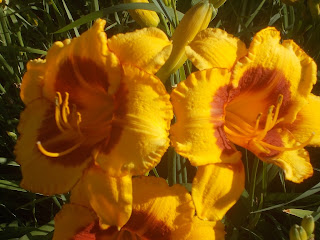What grows without too much trouble, looks beautiful and makes gardeners all over the world smile?
You could answer with a multitude of plant names and I'm sure that some gardeners, somewhere, would agree with almost any suggestion. The answer I'm looking for right now is Daylilies!
With over 30,000 different cultivars, you know that the plant world has taken this plant and just loved it so much that developing a new cultivar is like finding gold.
Hemorocallis is the proper name for the genus of Daylilies and comes from the Greek words Hemera (day) and Kallos (beautiful). So the Latin name is very appropriate and a straight translation. They are called Daylilies because each flower usually lasts only one day. One every stem though you can have 5 to 10 buds. So they last a lot longer than one day. July and August are the greatest months for Daylilies. They are blooming like crazy during the summer months.
Picture from my garden, please don't copy.
With over 30,000 different cultivars, it is highly unlikely that you will ever see all of these beauties in one place. There are gardeners all over the world who use their gardening skills to breed new cultivars of Daylilies in the hopes of bringing another beauty into being.
 |
| Picture Wikimedia Commons |
Developing new cultivars is not for the faint-hearted gardener. It can take 3 to 5 years and sometimes longer to develop a new strain and then it must be tested to make sure it comes true to it's cross and does not revert back to one of the parent lilies.
When I first fell in love with Daylilies, they just happened to be the most ordinary Daylily. Ordinary in the sense that they are common and found all over the world. They are just plain orange, but bloom with lots of buds on each stem, so they flower for a long time. Most people call them Tiger Lilies.
Today I have a few more Daylilies that are quite beautiful. I have fallen in love with one called Devil's Delight, that is a dark red/burgundy with a green throat. Ruffled edges on the petals make it look like a ladies evening gown. That root cost me a small fortune and looking at my pictures I realize I have never taken her picture. Sorry, I would have loved to share her with you.
I have neighbors go by my garden asking me for a root of that particular Daylily, but I am not so keen to share it.
The other one that I really like is called Moonlight Dance ( see the picture above) and she is yellow with a halo of darker orange and the edges are also the dark orange and ruffled as well. They remind me of ballerina tutus.
This weekend June 24-26th there is a Daylily Festival in Tennessee. If you are close by, I would say go and be prepared to be awed by over 200 varieties of Daylilies.
 |
| Photo by Ken Oakes |
Why Grow Daylilies?
As I was telling you earlier, there are so many Daylily cultivars, that I'm sure no one has seen them all in one place at one time. Why are there so many? Well I'd like to guess that it's partially due to the ease with which you can grow this plant. While it is originally from the Eurasian area, China, Korea and Japan, daylilies have found their way around the world and can grow in a variety of settings.
They can be large flowered with multiple petals, or large with singular petals. Some have stripes or rings, some are ruffled and others are not. Colors vary from the common orange, to dark reds, violets, pinks, yellows and everything in between.
Their root systems are so strong that they will get denser and denser as the years go by.
If you leave a clump of daylilies growing without any interference, it may take a pick ax to dig it out again. I tend to let mine grow for a year without disturbance, and then the next year, I will go in and remove some of the roots for planting elsewhere or sharing with friends and family.
The large strap shaped leaves look like a giant spider plant, until the spikes of flowers begin to show in mid-July. Then prepare yourself for some breath-taking beauty.
Some are scented and re-bloom later in the year as well, but not all of them. It's hard for any plant to be this beautiful and smell nice too! Whatever you don't get in scent is certainly made up for, by the depths of colors and intricacies in this plant.
Can I make some suggestions for your garden?
If you have never grown Daylilies I would start with this one, The Stella d'Oro is a rebloomer, meaning that it will bloom more than once. It is beautiful in it's golden color and it smells nice too! You will not be disappointed with this plant.
 25 Bareroot Stella D'Oros Daylilies--1-2 fan
25 Bareroot Stella D'Oros Daylilies--1-2 fan
Do you want to learn more?
I only made one suggestion for your garden because I could not possibly choose the others for you.
Rather, I would suggest getting this book, for some really nice summer time reading and dreaming.
You will enjoy seeing the multitudes of daylilies within the pages and the descriptions of what makes each one "special". It will also open your eyes to at least 1700 different cultivars that are available.
This book will become bookmarked with your choices in colors and types of daylilies. Leave it out in the open for your children to see, so next time there is a gift giving opportunity, they will know at least one thing that you would love to have in your garden. If you are inclined you could even use some sticky notes to mark out your favorites.........Sneaky, right?
 The New Encyclopedia of Daylilies: More Than 1700 Outstanding
Selections
The New Encyclopedia of Daylilies: More Than 1700 Outstanding
Selections
I prefer to be this kind of sneaky and get something that I really want in my garden than to have my kids bring me cut flowers that will surely last only a few days. This way, your plants will come back year after year becoming more beautiful with the passing of time. They will be a living reminder of the gift given once and enjoyed ever after.
Just one word of caution, once you have one daylily in your garden, you will want more!
Note: The author may receive a commission from purchases made using links found in this article. “As an Amazon Associate, Ebay (EPN), Esty (Awin), and/or Zazzle Affiliate, I (we) earn from qualifying purchases.”







![Castle Garden, New York Immigration Center, 1866, By Unattributed [Public domain], via Wikimedia Commons Could You Survive Emigrating to An Untamed Land? A Book Review](https://blogger.googleusercontent.com/img/b/R29vZ2xl/AVvXsEjEOv1S6tuQVC4tfSpwTP83Y82PVHxfpefPqK5MB7ow6w0tn_BbyCQJNeW_PRC_g2U9gWWK0HDGbodm5L7oRBKL5QcOYvDM6Sh7L4XdBeV3n-xsDrA4B5_J22gAIs8PlrSgioHethsvB4SS/s1600/512px-Immigrants_at_Castle_Garden%252C_New_York_City%252C_1866.jpg)


































































